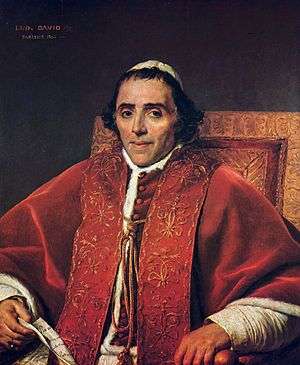Papier-mâché tiara

The papier-mâché tiara is a papal tiara that was made in exile for Pope Pius VII's papal coronation in a church in Venice. In 1798, Pope Pius's predecessor Pope Pius VI had been forced into exile when French troops invaded the Vatican and stole or destroyed all the ancient papal tiaras owned by the Holy See. When the ill Pius VI died in exile, the College of Cardinals elected Giorgio Barnaba Luigi Chiaramonti to the papacy.
A coronation was arranged for the new pope in a church in the cramped Benedictine monastery of San Giorgio on 21 March 1800. However, the church lacked a papal tiara with which to crown him. At short notice, a temporary tiara was manufactured using papier-mâché, with local aristocratic ladies donating their jewels to decorate the new temporary crown.
Continuing usage
The new tiara was intended to be temporary, but it continued in use for a number of decades, even though one tiara — the Tiara of Pope Gregory XIII — survived the destruction of 1798. Although Napoleon did donate a replacement tiara to Pius VII some years later, made with jewels from the tiaras destroyed by his troops in 1798, the new tiara was deliberately made too small and too heavy to be worn. It is doubtful whether Pius would have worn it in any case, given the circumstances of its creation and given that, in the past, he had been held captive on Napoleon's orders and threatened physically on occasion. Furthermore, it is reported that originally this tiara contained small plaques engraved with the names of Napoleon's principal military victories, which a cardinal later quietly replaced with ones bearing scriptural verses.[1]
A new silver papal tiara to replace the destroyed ones was only manufactured in 1820, but the papier-mâché tiara continued in usage for decades afterwards, its lightweight design making it a comfortable alternative to the heavier silver alternative for popes as they aged. It was finally officially retired from usage in 1845, when a new lightweight tiara was manufactured for Pope Gregory XVI. Contemporary reports suggested that Pope Gregory viewed it as demeaning that the Vicar of Christ should be seen wearing a crown made not from gold or silver but from mere crushed paper.
It was however claimed that Gregory's successor, Pope Pius IX, still occasionally wore the more comfortable papier-mâché tiara during long religious ceremonies, when it could not be easily recognised from a distance.
No pope since Pius IX is known to have worn the papier-mâché tiara. Subsequent popes had a large number of lightweight tiaras to choose from.
See also
References
- ↑ Lord Twining, A History of the Crown Jewels of Europe, 1960.
